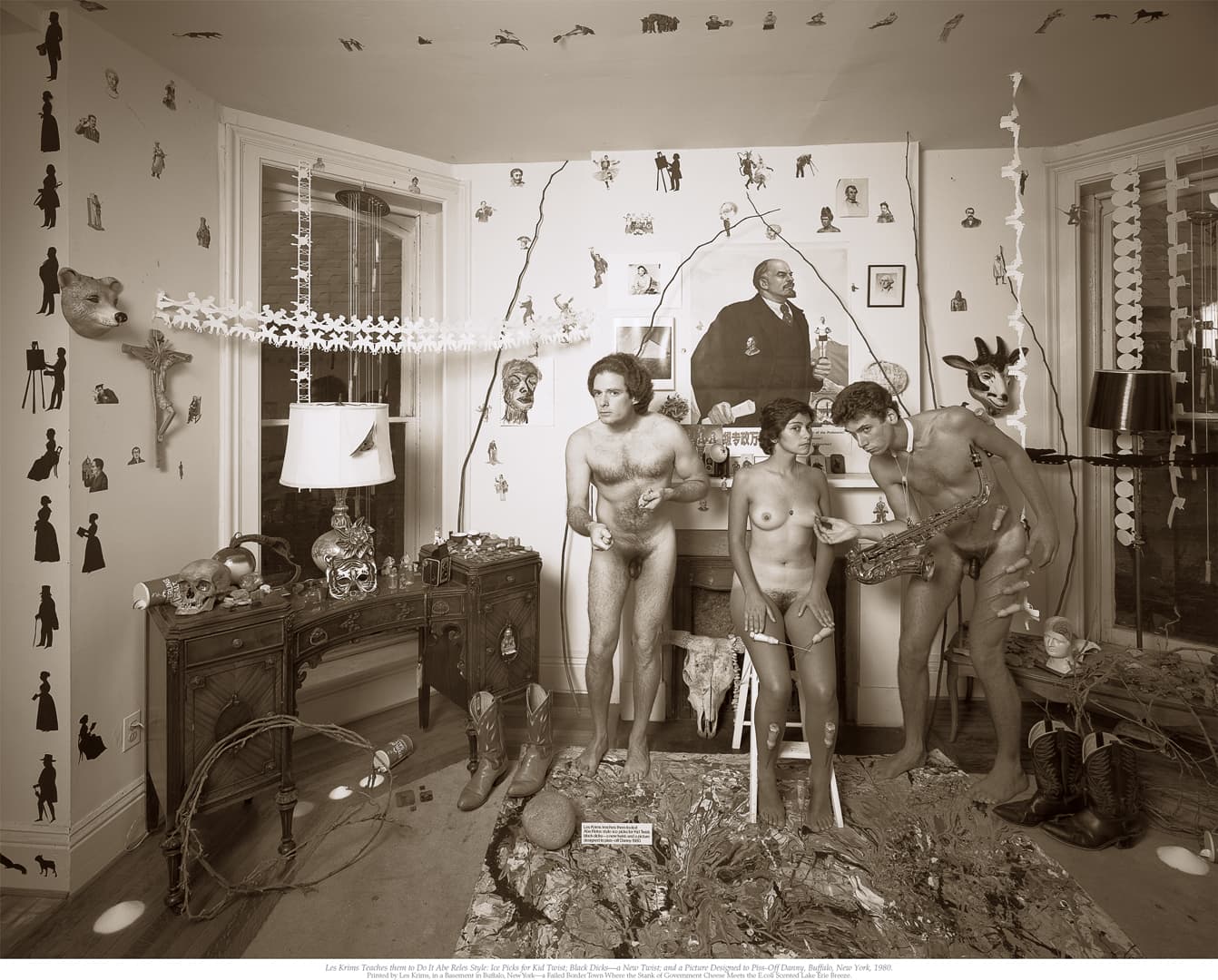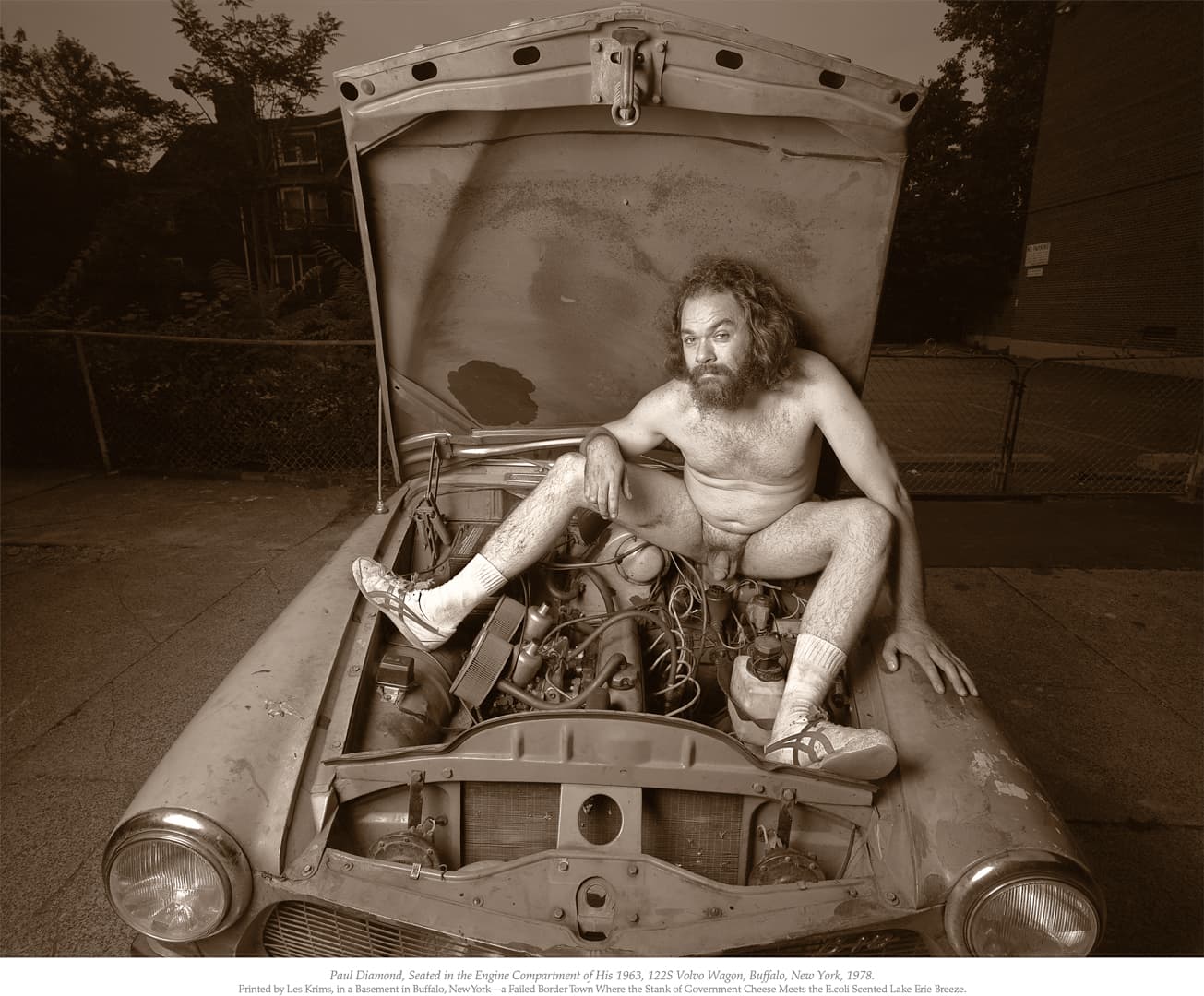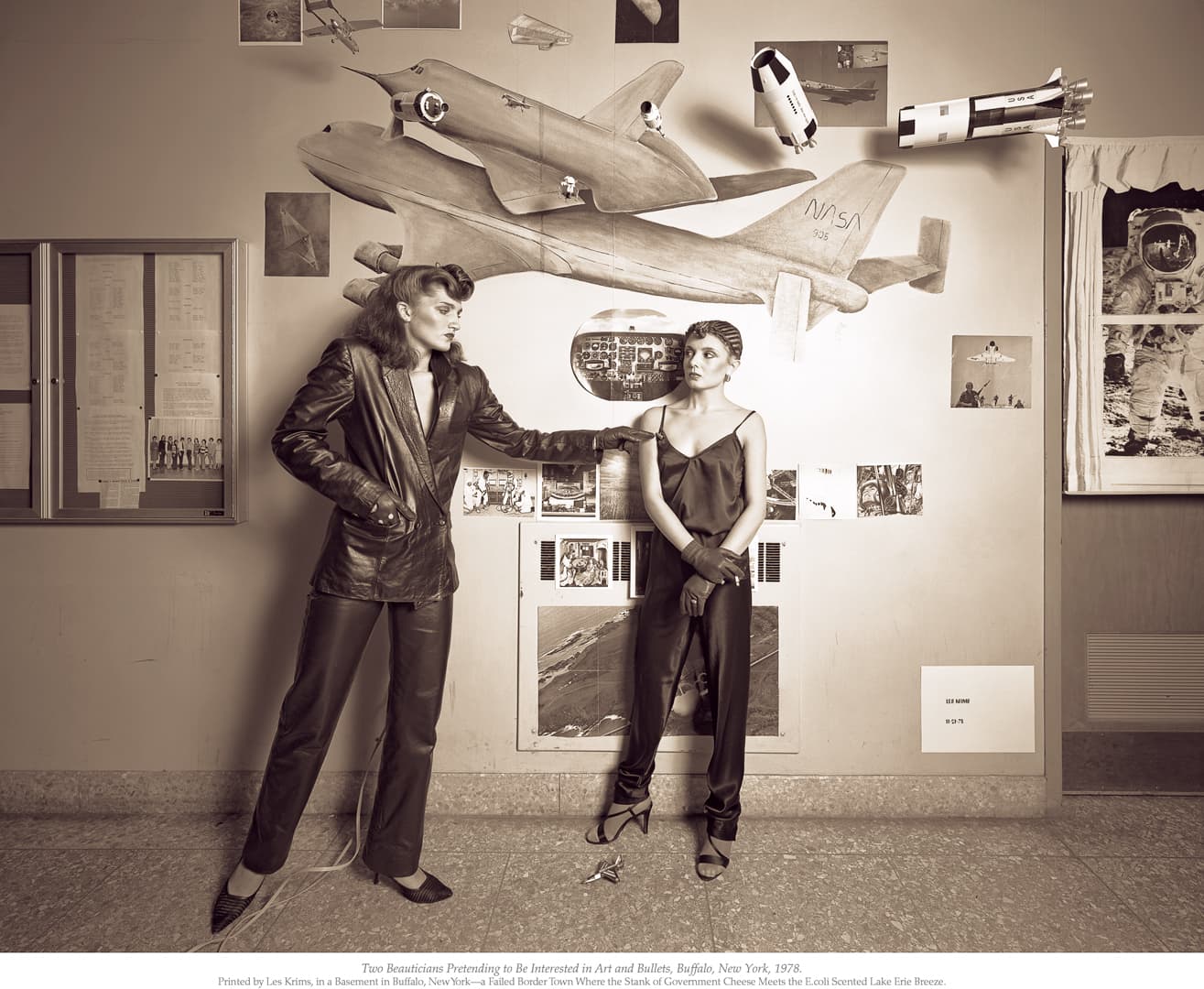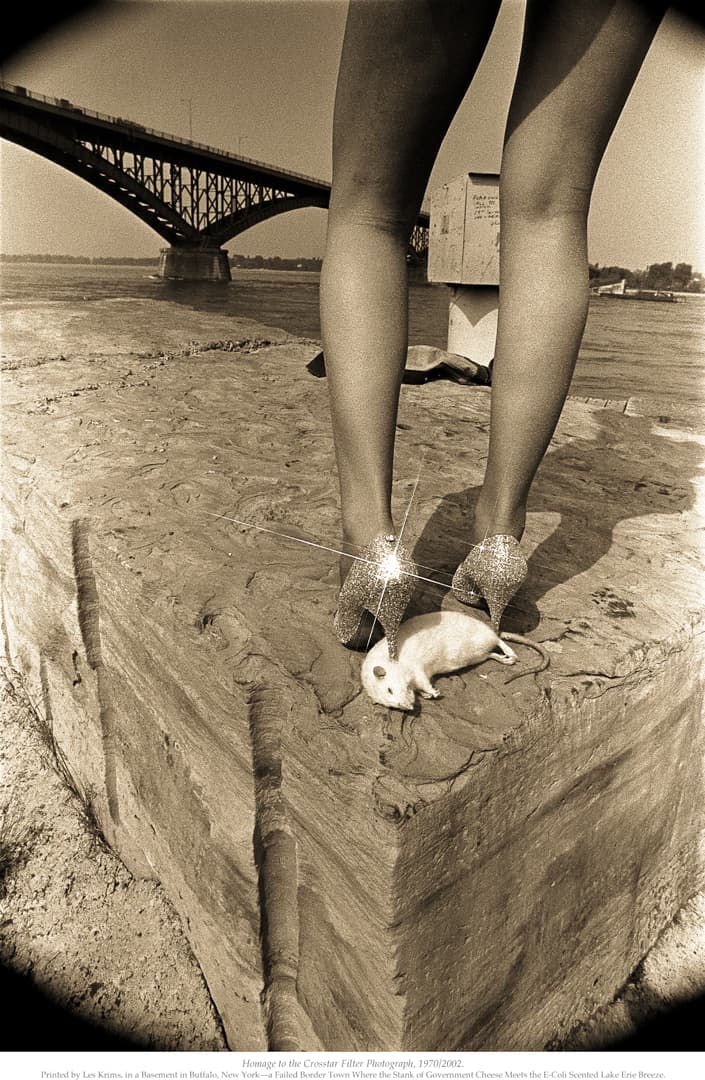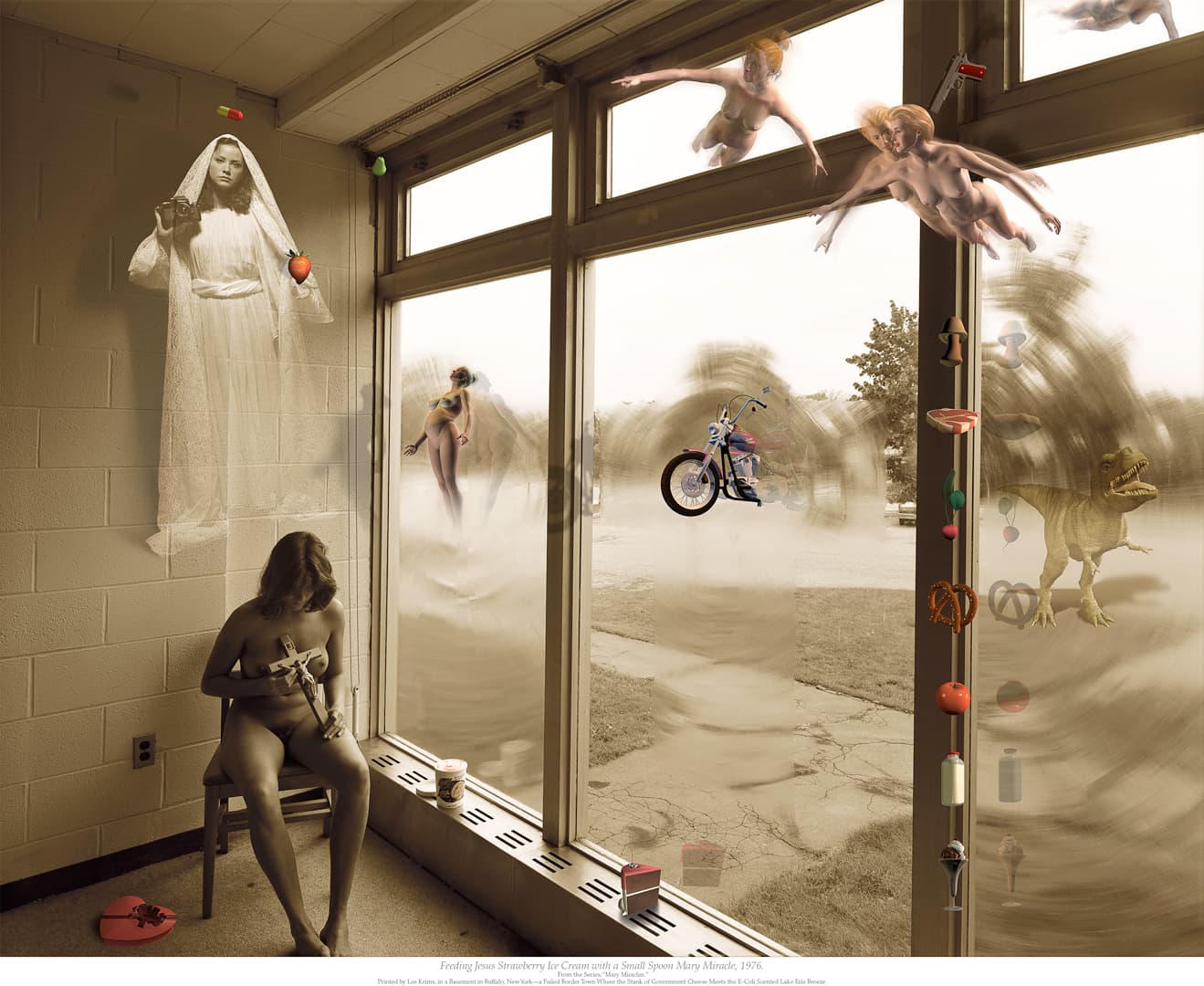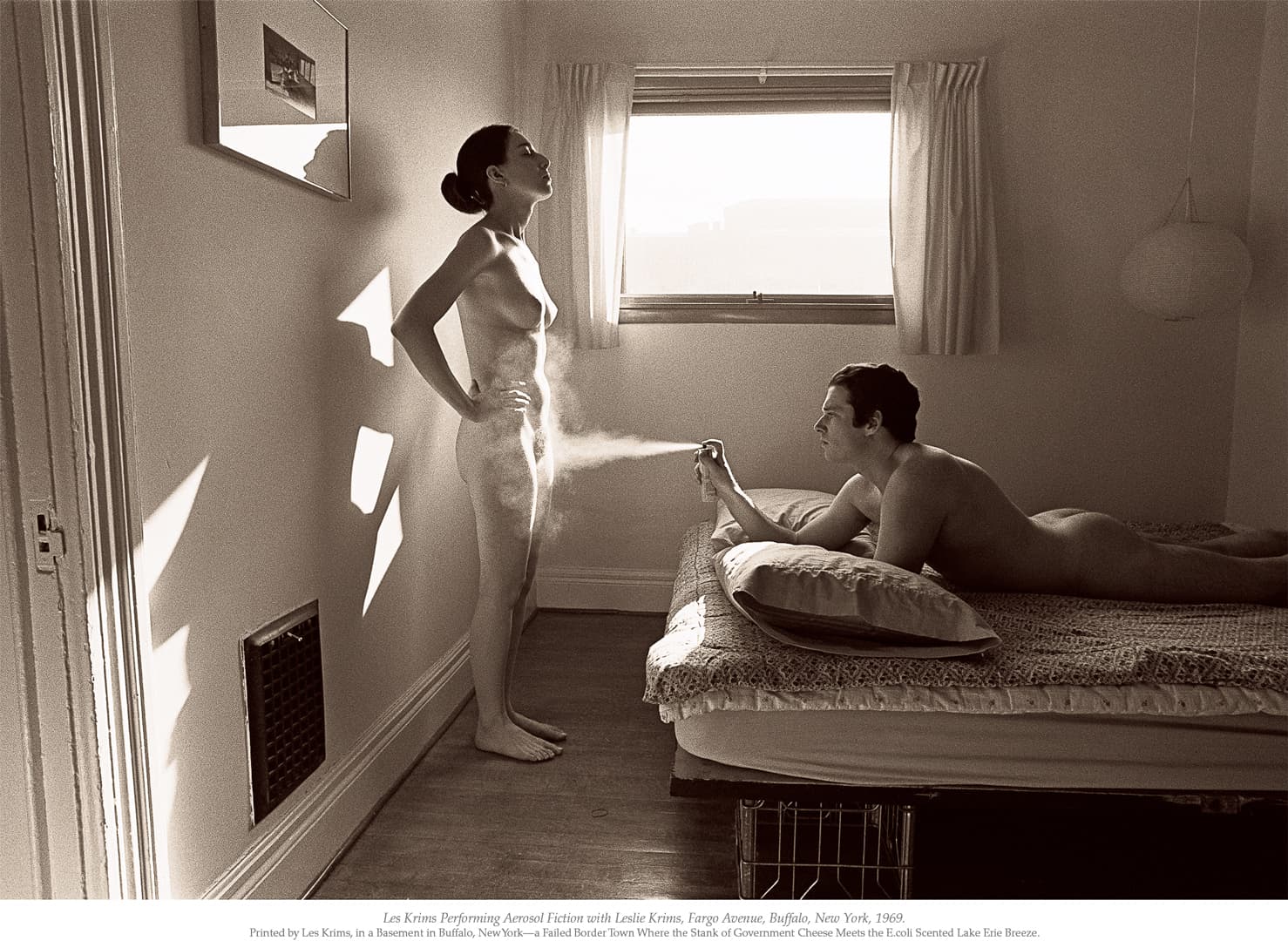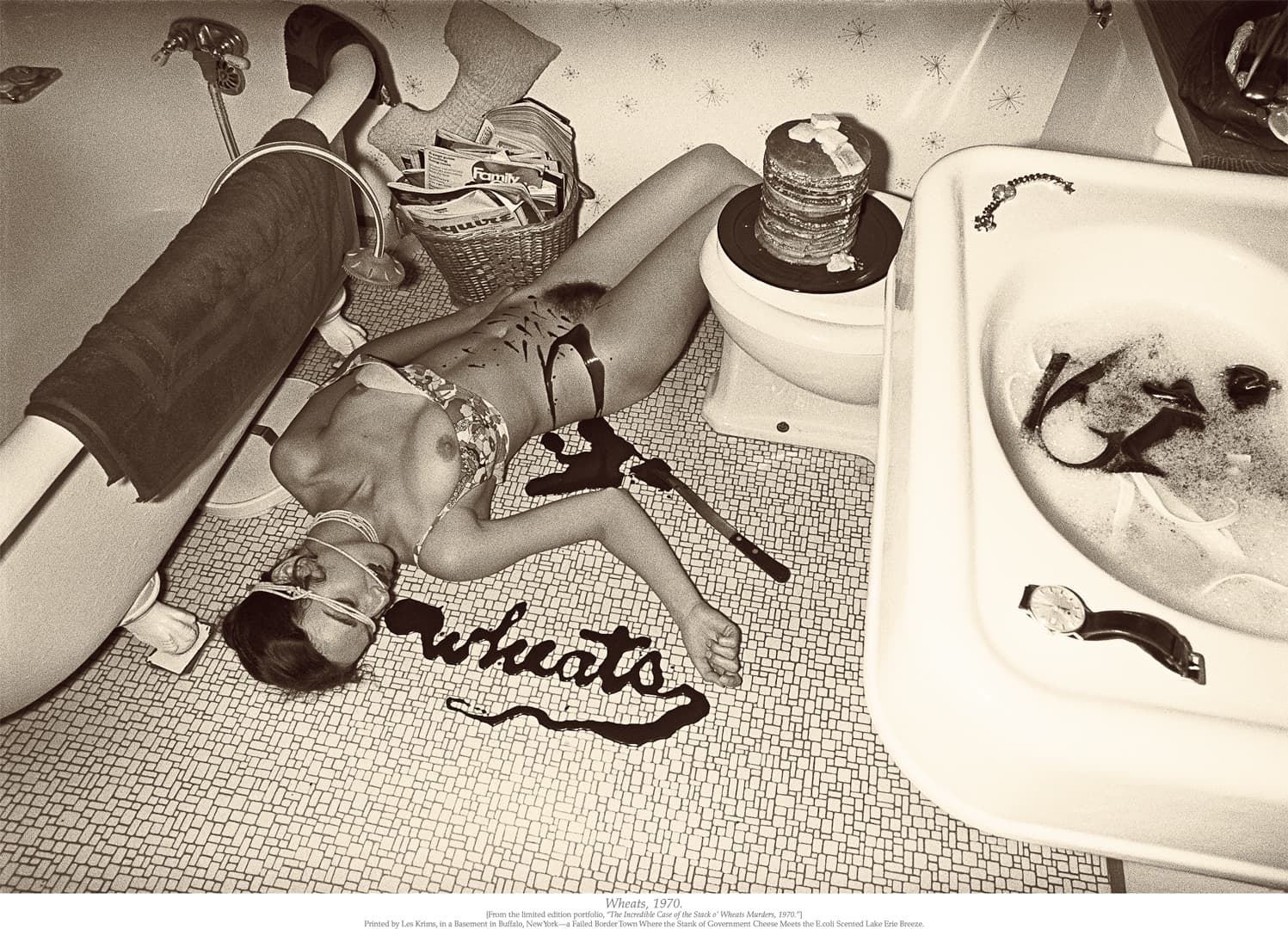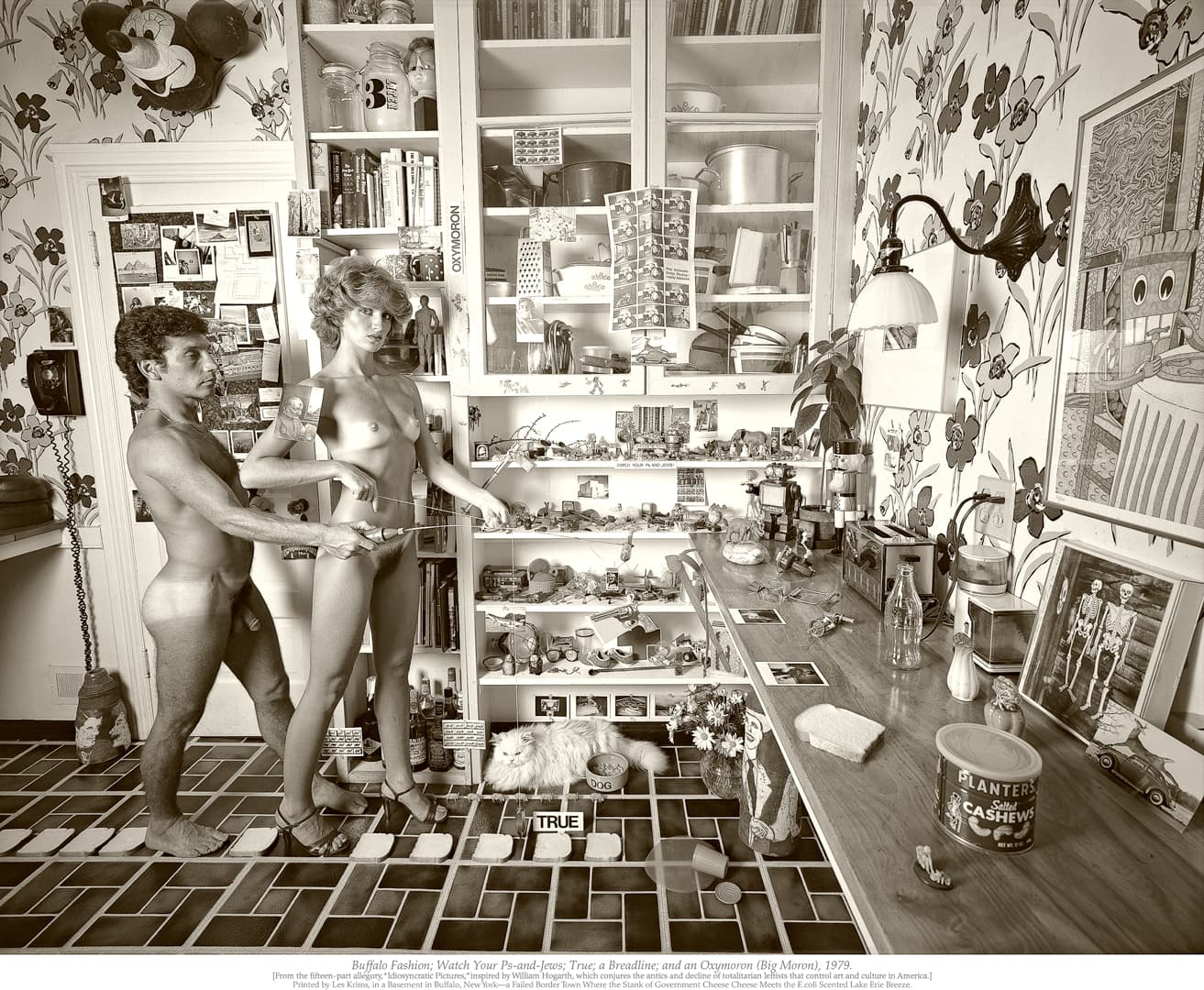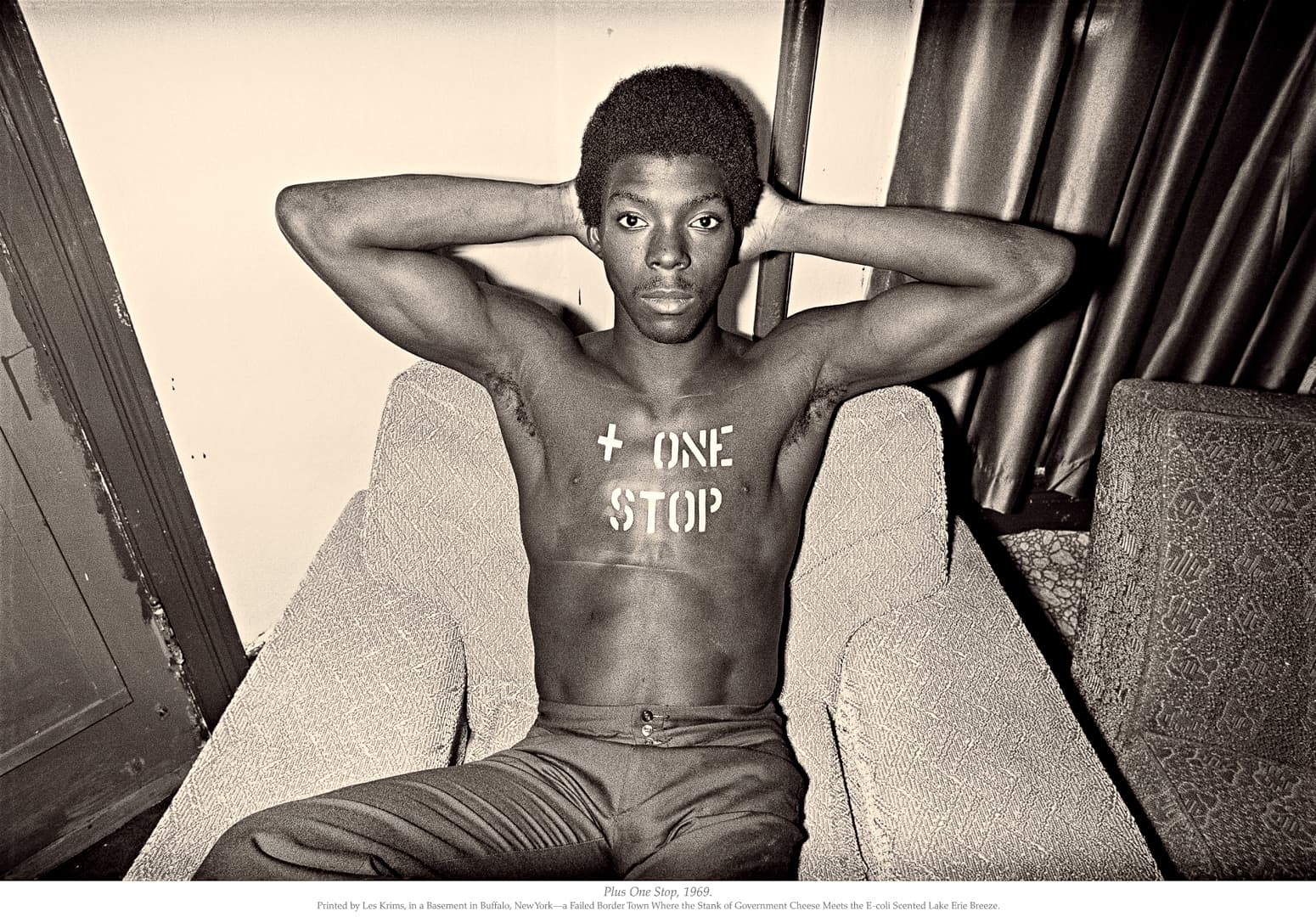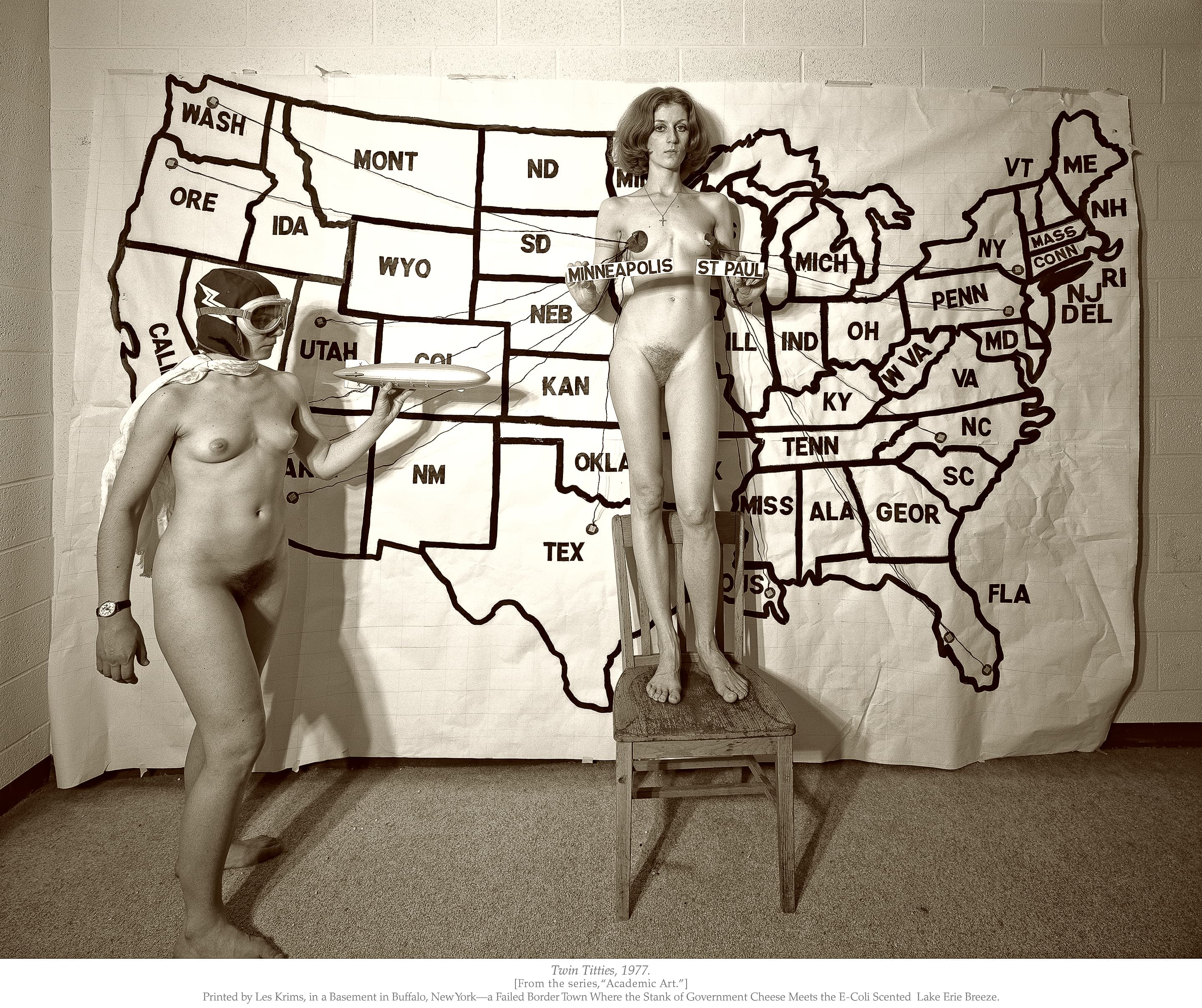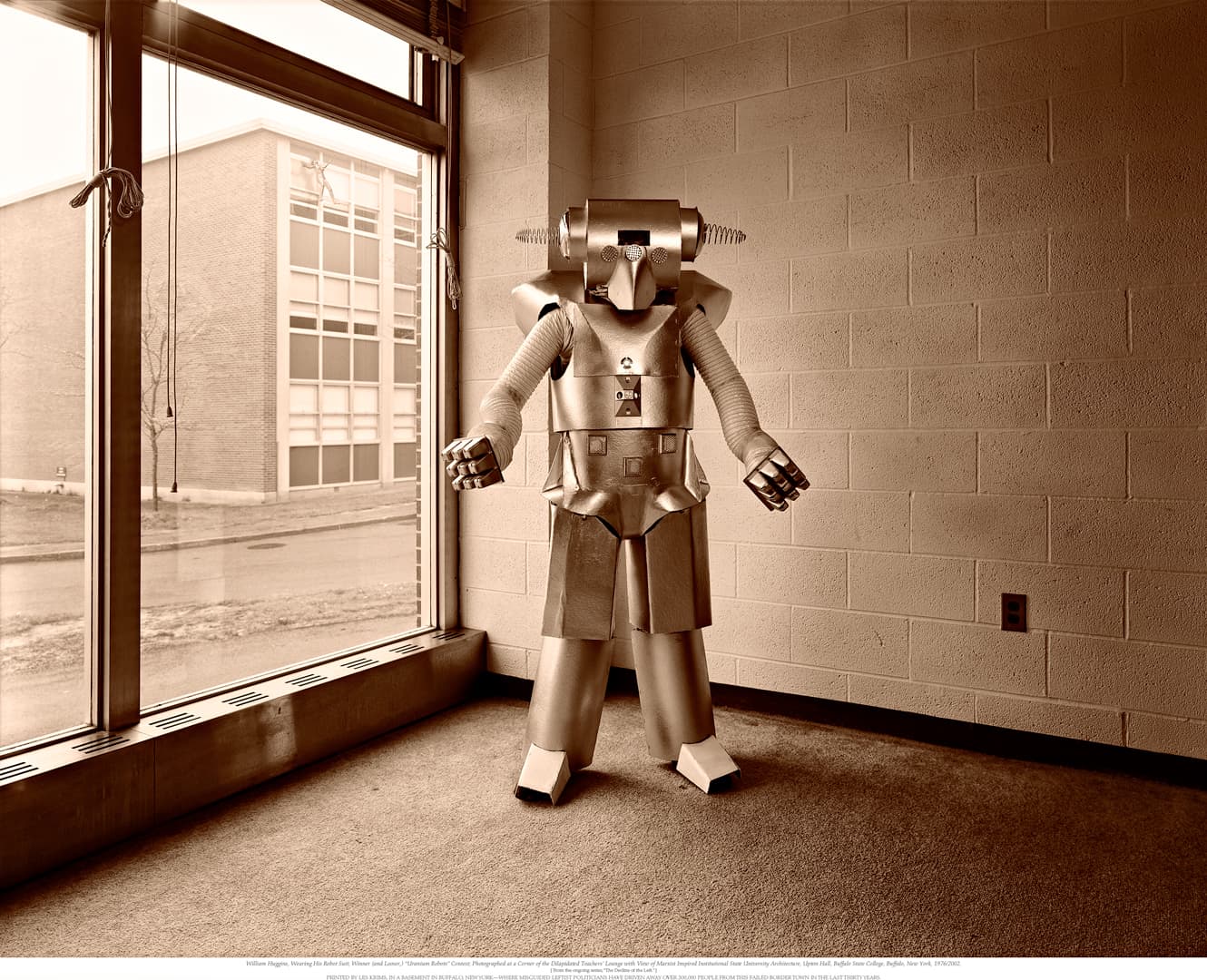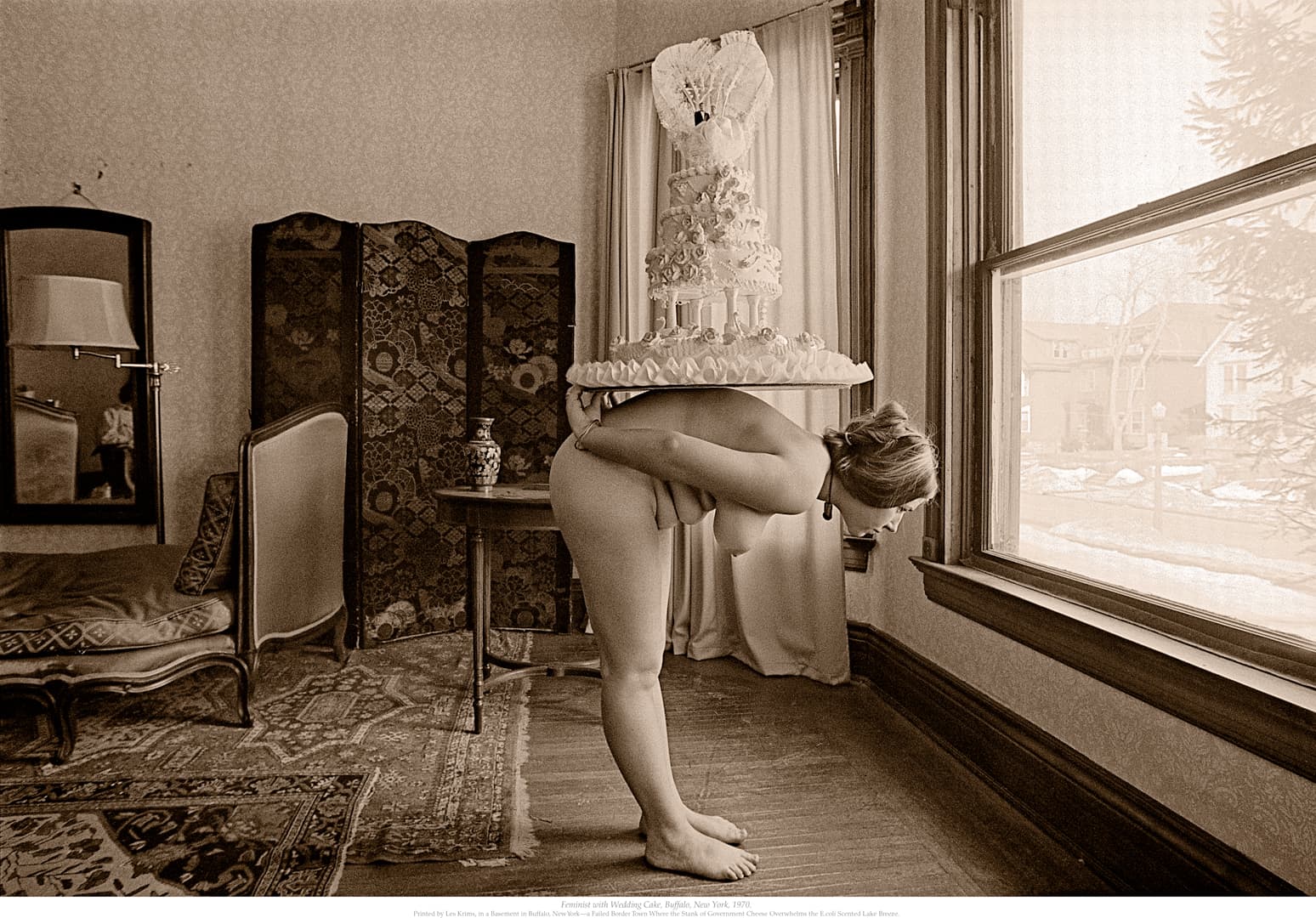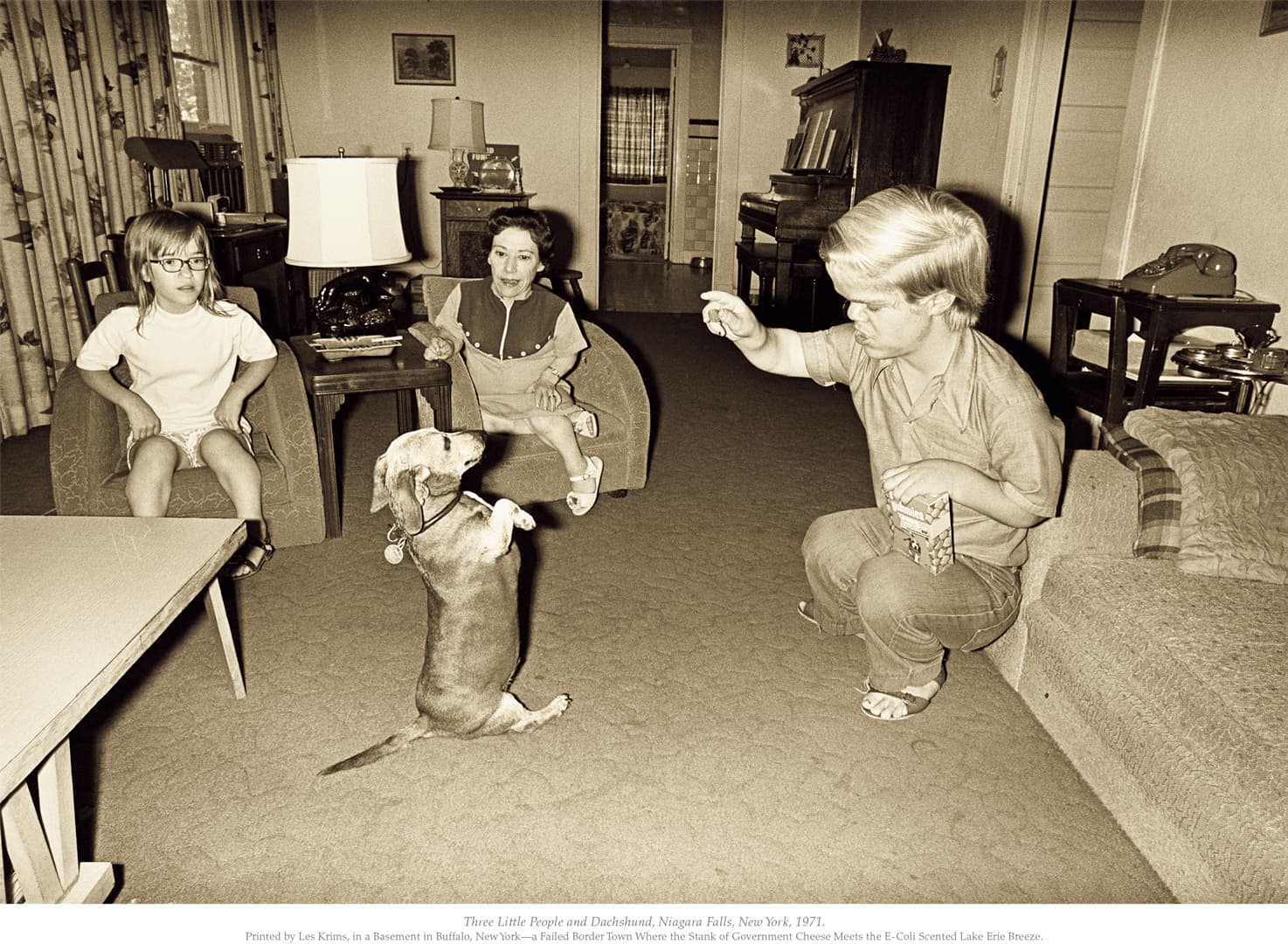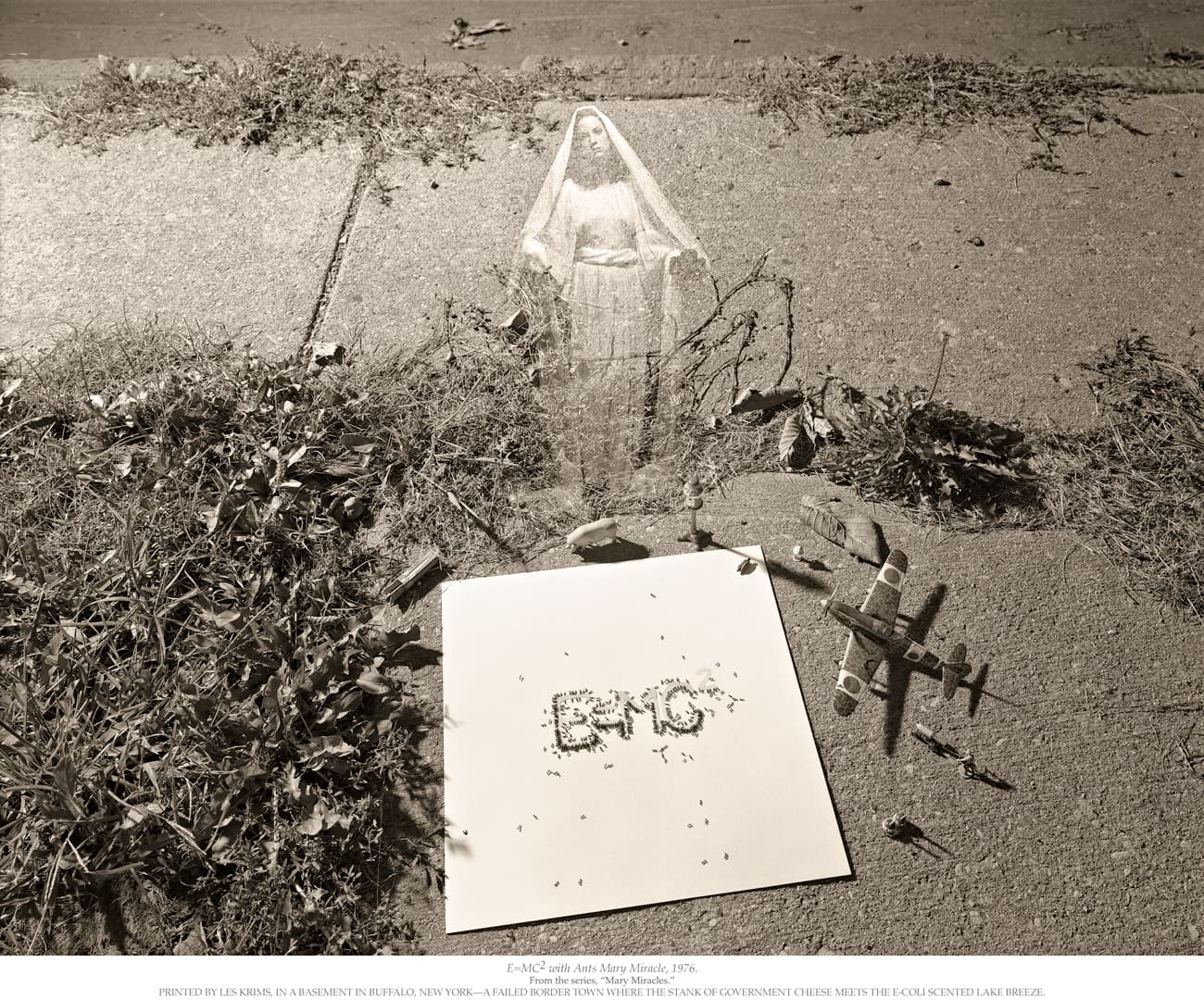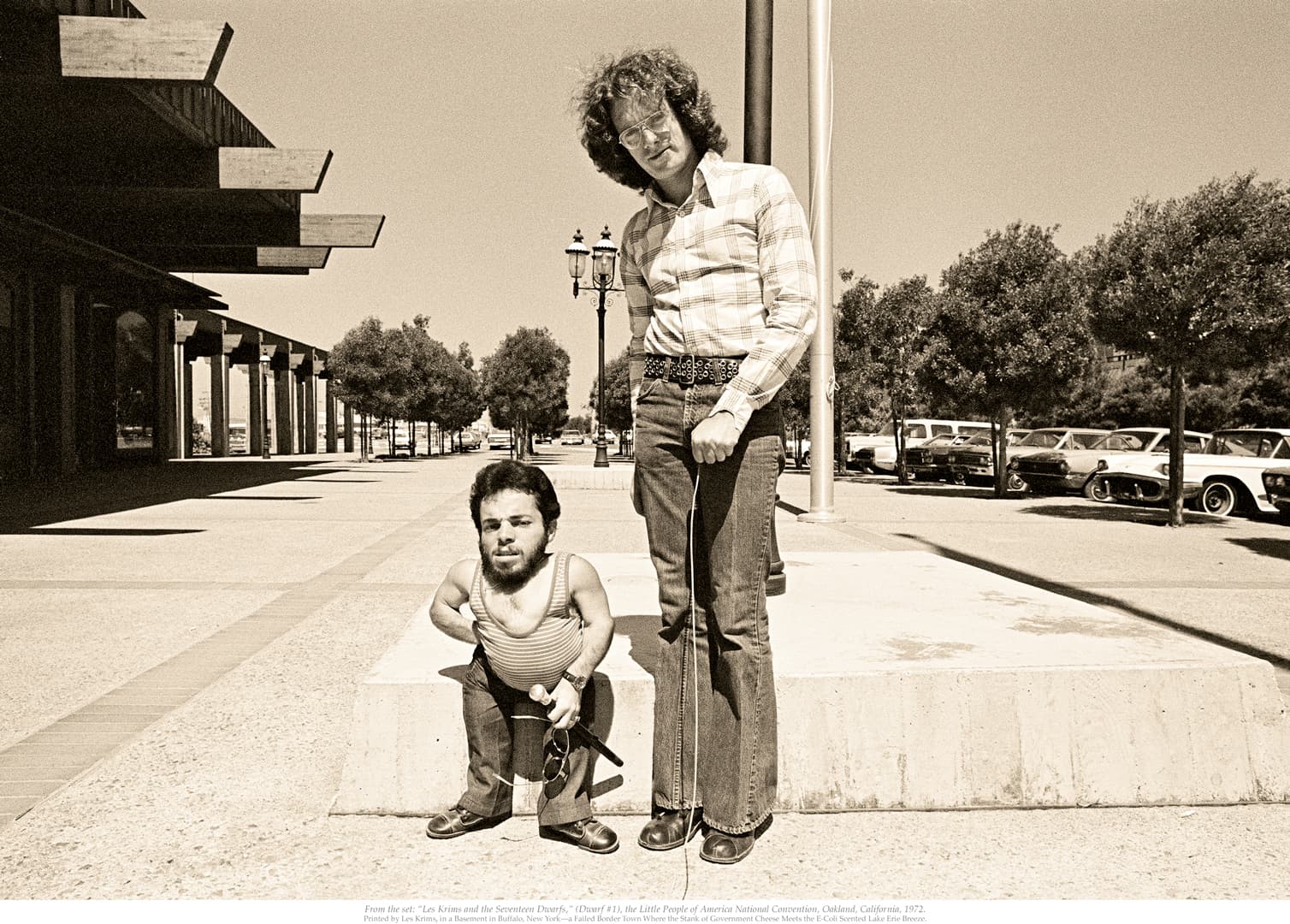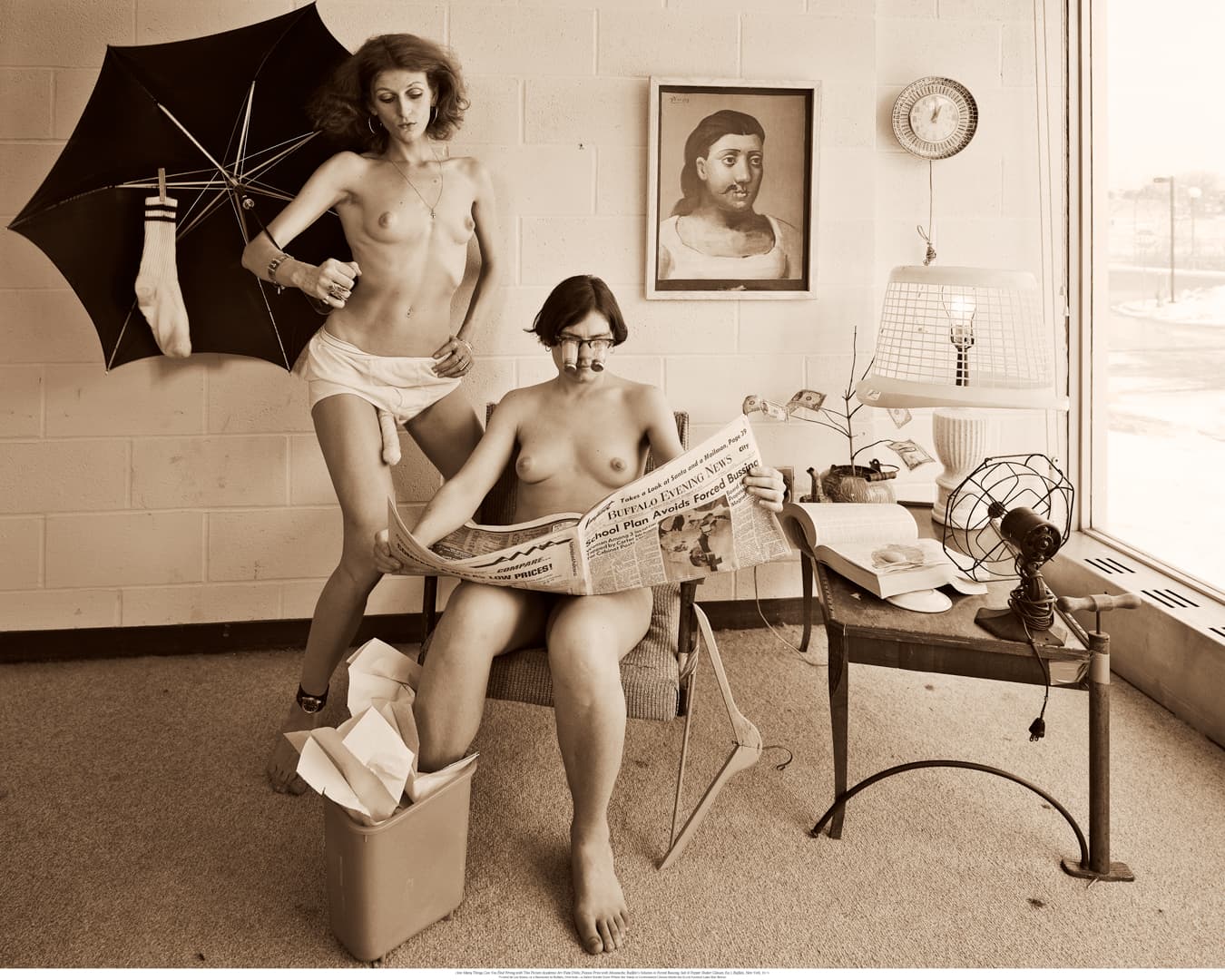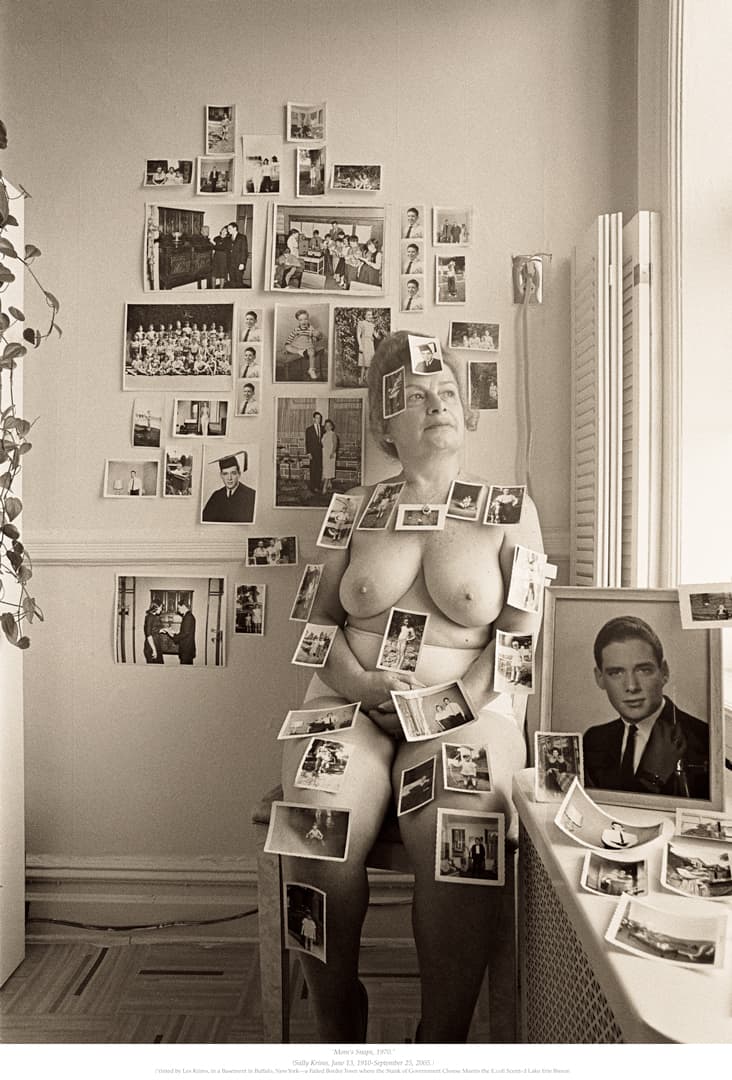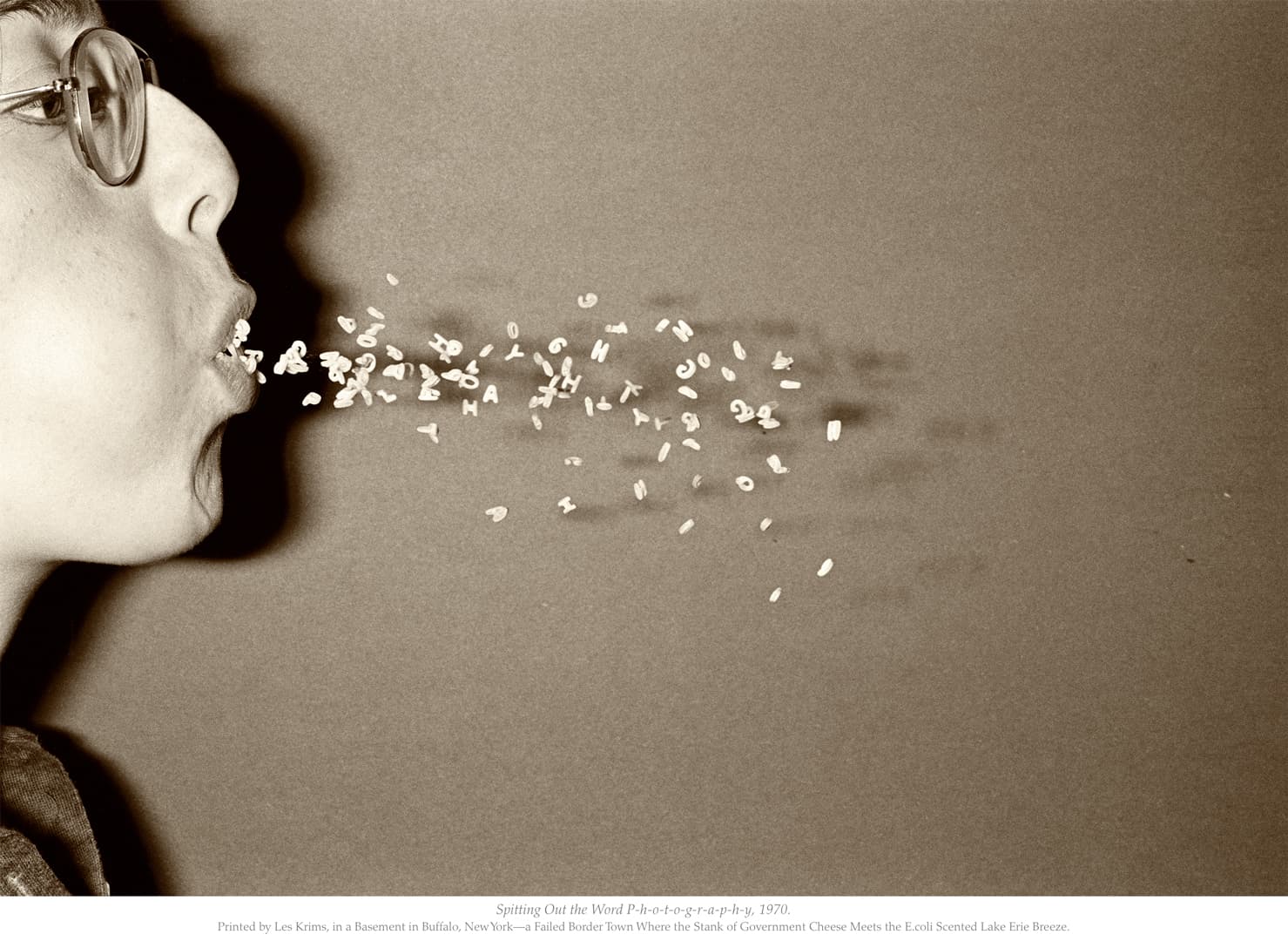An Unpublished, Unvarnished, Interview with an Independent Artist
Years ago, the editor of "Tokion Magazine," Ken Miller, wrote to inquire if I would do an interview. I said sure. Miller emailed a set of questions.
It's taken years to write my answers. And Ken Miller hasn't seen them. The space allotted for interviews in "Tokion" was small, and I dragged my feet and rambled on. Fortunately, the length of a text is not a big concern in cyberspace.
Ken Miller: You are originally from Brooklyn, but you avoid the NYC gallery network. Why is that?
Les Krims: I grew up in a two-room apartment in Brooklyn. Though I can think of worse places, the twenty-three years I lived there were uncomfortable, spare. When I graduated from Pratt, prospects were uncertain. Like Snake Pliskin, I wanted to Escape from New York.
I moved to Buffalo, NY, in 1969, and snide remarks greeted my Brooklyn accent. Paradoxically, in a very few years, the children of the people who mocked my accent were leaving Buffalo to find work elsewhere. Some wound up living in Brooklyn, which was becoming fashionable. (In the last 4 decades, Buffalo's misguided politics and high taxes have pushed jobs and over 300,000 people out of the this city.) These Buffalo refugees found apartments in newly gentrified safe zones carved out of the ghettos surrounding them; and they began having children...
Upstate refuges avoided the public schools hobbled by nihilistic ideology and misguided politics (read Daniel Patrick Moynihan's essay, Defining Deviancy Down). Their children rode the subway in rush hour to attend private schools (their parents went to private school, and so would they). I've lost my Brooklyn accent. But the grandchildren of the folk who needled my pronunciation now speak with a Brooklyn brogue. Here in Buffalo, a three-minute drive through Buffalo's mean streets, and I'm at work. But I still miss New York's pizza and Chinese food (the fried chicken wing is Buffalo's single culinary claim to fame.) All in all, moving to Buffalo's been tolerable.
At 27, I had my first exhibition at The Witkin Gallery. Unknown one day, in no time, I had a "reputation." In 1969, the Witkin Gallery was the only commercial photography gallery in New York City. I was a new fish in Lee Witkin's small pond. The artsy folk I met at Witkin's gallery openings were strange, middle class. Their main entertainments seemed to be drugs, radical politics, and ethnic food (I shared their affection for the food). The wacky ideology they professed, and dislike for America, bewildered me.That has only gotten much worse. (The Painted Word, written by Tom Wolfe, offers an enlightening, entertaining read about those times in New York City's art world.)
In the years between 1969 and 1981, naively seeking better sales, I moved from The Witkin Gallery, to Light Gallery and, finally, to Robert Freidus Gallery. Lee Witkin purchased pictures from me as long as he was alive. Light Gallery and Robert Freidus Gallery sold little. However, my own modest commercial ventures publishing books and small offset folios were fairly successful. I made a profit, and enjoyed making the works.
In the fall of 1978, a unique opportunity presented itself: Gallery owners, curators, and collectors from the U.S., Canada, and Europe would be attending a print collecting symposium and auction hosted by the George Eastman House, in Rochester, New York. Photographs were beginning to be exhibited in galleries that showed painting! Eureka! The George Eastman House event was a celebration of that change. There was a sense that photography had arrived, that it was hot! I had doubts.
Most of the galleries, and a good part of the market for photography, would be at GEH, in the same place at the same time (a first, then—many years before AIPAD). I devised a simple plan, determined to sell my photographs at the symposium to whoever might be interested.
Light Gallery represented my work in 1978. And Light's representatives, Lawrence Miller and Peter MacGill, would be at the Eastman House symposium (those names ring a bell?). I explained my plan to Peter and Larry. Without any explanation, they refused to offer my work at that event. I decided to represent myself. A $40 fee, paid in advance, would allow me attend, and to roam about for three days, toting a film case full of prints, a pack of invoice forms, and a ballpoint pen.
On the symposium's last day there would be a fundraising print auction complete with auctioneer from Christies. The auction would sell work donated by contemporary photographers, using the proceeds to purchase the work of contemporary photographers for the Eastman House collection (say that again!?). Tables were set up throughout the exhibition areas at G.E.H., so that galleries and dealers could hawk photographs. I reasoned that these folk would not be selling contemporary work to each other, and the city of Rochester, home of Eastman Kodak, paradoxically, was not a lucrative market for art photography. Dealers and galleries still made most of their money selling old paper, as it is known, in the antiques trade—historical material in limited supply. I knew that Lee Witkin saw no reason to attend. I believed sales of contemporary photographs at the event would be slim to none.
The George Eastman House held a moderately successful mail auction the previous year, using the same odd plan: selling donated contemporary photographs to purchase contemporary photographs (a standard heads I win; tails you loose idea for the gullible artist even now). The year before, flattered to be included, and seeking the imprimatur of a listing in the catalog, photographers had donated work, naively failing to set minimum bids. Nobody was donating anything this year. Minimum bids were in place based on theoretical top dollar valuations at which most prints had never sold. The mechanism on display, this year and last, appeared to me to be a new incarnation of the legendary perpetual motion machine.
I reasoned that if I offered a limited selection of my pictures (some specifically fabricated for the auction) at a bargain price, at an event where no bargains would be available, I might sell some. (The deal: Any print from a selection of 36 contact prints, made from 8x10 negatives, for $50 each— inexpensive even then. The hook was that 10 of my prints—$500 dollars worth—had to be purchased at once to get that price. In two days I sold hundreds of prints, including an edition of 50, of an 11 print set called "Please!")
An odd and unanticipated consequence of the Eastman House caper is that those few pictures now, in large part, are the only pictures that represent my work in many museum collections throughout America. I'm continually surprised by where those bargain prints show up. The power of a tax advantage is not to be ignored.
The pictures offered at G.E.H., were selected from a series called "Academic Art," or fabricated specifically to satirize the symposium's hustle ("Please!"—an 11-picture set of 8x10 contact prints of my 68-year-old mother in her bikini, carrying a cane, tin cup with pencils, sporting dark glasses, pretending to beg in Buffalo's dusty summer streets. Each picture was made as she screamed the word PLEASE!). Young artists might want to consider the effectiveness of a good hook and "price point," that the practice of collecting is herd-driven, and, the fugitive nature of what is "hot."
In 2007, I launched a website to sell carefully crafted, archival ink jet prints. This venture's hook is similar to the one used at G.E.H., in 1978: an affordable price for memorable pictures when few bargains are available.
Ken Miller: How has your approach to photography evolved?
Les Krims: When I started to make photographs, it seemed to me that much of serious photography was mired in slumming excursions funded by affluent folk eager to see what danger looked like. These pictures produced instant catharsis for their viewers, and changed little or nothing for those photographed. Art photography as such, was a small industry, an amalgamation of arts and government agencies, which used the poor and damaged as the raw material for a perverse entertainment: making socially concerned photographs. The pictures fed this industry's voracious appetite for propaganda. The culture industry, politicians, and the rapidly expanding bureaucracy of the welfare state, used photographs to prove that the problems—which rationalized the money spent to employ them all—had not changed. This was another, and perhaps the worst, of the culture industry's perpetual motion machines. Photographs fueled this machine. In contrast to this retrograde, cynical practice, New York in the 1960s & 1970s, was chockablock with "ism" after "ism." Creative energy was in abundance. All of this influenced my work.
In graduate school, I began constructing situations (simple tableaus) to be photographed. I called these satirical pictures "fictions" (it seemed clear to me that a photograph was pure illusion, easily manipulated, fictional). A note, or a simple sketch to help objectify and remember an idea, often began the process.
In my second semester of graduate school (1965), Owen Butler (Pratt's photo lab assistant then, now a professor at R.I.T.) showed me a calendar of photographs used to promote the Horn/Griner Studio. The pictures were flamboyant tableaus, and the reproductions had a distinctive look. I asked Owen how the reproduction prints for the calendar were made. At first he said it was a secret (Owen worked at Horn/Griner as studio manager). Eventually, as a graduation gift, he told me that Kodalith Ortho paper was used, but nothing about how to use it. I bought some, experimented, and began to use this to print my pictures.
I found the work of Jeanloup Sieff, Art Kane, Hiro, and other fashion and editorial advertising photographers fascinating, great to look at, and a welcome antidote to the gloom and doom of activist photography. Most of these photographers were innovative craftsman, and used extraordinary new optics. I discovered I had a great affection for wide-angle lenses.
Recommended by Peter Bunnell, to his friend Bradley Hindson, I now had a job teaching photography at R.I.T., and lived upstate, in Rochester, NY. On a trip to NYC, in 1968, I saw a Lawrence Weiner exhibition at the Seth Siegelaub Gallery. The exhibition consisted of framed, letter size, typewritten statements—not pictures. The words described simple "acts."
I felt an affinity for Weiner's quirky approach, and the proletarian, commonplace images his words described. When I was a kid, I'd poured a gallon of discarded paint in a hole-in-the-ground in a vacant lot; shot my BB gun at a wall in our apartment, and examined the dimpled depressions. From time-to-time, in Fall, I set fire to small piles of leaves gathered along curbs on 63rd Street to see and smell the drifting smoke. Taking care to avoid lines of drying wash, I shot balsa wood model rockets powered by tiny, solid fuel, Jetex Type 50 rocket motors, off my apartment house roof, aiming for Coney Island. Some of Weiner's pieces sold permission to a collector to do things for which, these days, Ritalin might be prescribed.
By the end of the 1960s, conceptual art; new optics; advertising photography; the satire and uncompromising language of Lenny Bruce; Rube Goldberg's odd contraptions; Willem deKooning's "Women;" Art Povera; small, inexpensive multiples; Richard Lindner's paintings of tough, common women; Henri Cartier-Bresson's elegant, spare photographs; and William Klein's teaming pictures and beautifully printed books had all made lasting impressions. As the 1970s progressed, I enjoyed Peter Saul's wild, irreverent, expressionist parodies of history painting; the Hairy Who; Duane Michals's narratives; Lucas Samaras's SX-70 manipulations; Guy Bourdin's fashion work; and the edgy, candid work of my friend Paul Diamond. As much as I liked Henri Cartier-Bresson's work, my pictures remained anti-decisive moment.
Through the 1980s, my methods evolved. I began to influence the interpretation of carefully selected "candid" pictures, using texts, to parody the manipulative intent of activist photographers. My pictures presented a point of view not offered in leftist-controlled media (CBS, NBC, ABC, The New York Times, public radio and television, etc.). By "spinning" documentary images with texts, strangers could be transformed into actors in believable tableaus. The Left's methods for manufacturing propaganda were appropriated to criticize the left, needling media and art practice. "Making Chicken Soup" had attempted this, years earlier; my newer pictures were more explicit.
I used a variety of cameras and film formats over the years. Self-taught as a photographer and user of computer technology, my skills evolved gradually, unhampered by what seemed to me to be an academic art establishment, which fed a radical, ideology-laced Cool-Aid to students, designed to kill those parts of the brain controlling common sense and self-expression. In the 1980s, the left saw clearly that the Soviet Union would fail. Though they controlled culture in this country, their ideas had atrophied. It appeared to me that the left's Kamikaze-like plan was to take art down in flames with them and their failed revolution. I photographed avidly, inspired by odd American culture where aberrant behavior was exploding.
Along the way, the amazing potential of digital technology became clear, and I waited for computers and high-resolution ink jet printers to become affordable. Computers, film scanners, and ink jet printers are now pivotal to making my pictures and prints. Capitalism and commodification made it possible for artists working with cameras to own the means of production.
Ken Miller: Is your documentary photography (street photography, etc.) your older work?
Les Krims: I'm not exactly sure to which pictures you're referring. If you mean The Little People of America, 1971, The Deerslayers, or The Incredible Case of the Stack o' Wheats Murders?: Yes, those are older (all were published in 1971). But they were made to criticize socially concerned photography (a.k.a.: street photography), and its content. Initially, those works challenged the use of a photographic image as evidence, and underscored how photography was morphing. Considered together, those three offset portfolios announced a synthesis of methods and ideas—a fusion of the conceptual, candid, and commercial, which I believed would displace prevailing practice in art photography. I called my pictures "fictions." (In a 1970 article in Camera Mainichi, my notion of a photograph being a fiction was published to accompany an article reproducing my work.)
The Deerslayers, asserted hunters to be conceptual artists making sculpture. Near the end of Vietnam War, radical leftist activists using nasty ad hominem attacks, characterized any gun-toting hunter as a murderer; police, as some may remember, were called "pigs." My tongue only slightly in cheek, I suggested that deer trussed to cars, pick-ups, and campers—commonplace in upstate New York during hunting season—could be understood as sculpture, and a "performance" the artist Hermann Nitsche would enjoy. The title for the set was suggested by James Fennimore Cooper's novel, "The Deerslayer." Those pictures were meant to conjure a creative appraisal and positive spin for a utilitarian sport practiced by many normal people living outside the radical-intellectual epicenter of New York City. Most deer hunters ate what they shot. It's my guess that many lefty intellectuals would have strapped-on a Glock and gone hunting, too, if lox ran wild in Central Park. (An original print portfolio in a flocked clamshell box was produced containing shotgun shells, deer targets, deer hide, antler tips, and other objects.)
The Little People of America 1971, was selected from photographs made at two national conventions of the Little People of America. The L.P.A., was founded by the 3-foot-9-inch actor, Billy Barty. Members of the L.P.A., were primarily achondroplasia and hypopituitary dwarfs. These people annihilated the stereotype of "dwarf" presented by art history and socially concerned photography. The Little People of America, 1971, embodied American spirit at a time when the left was pissing on this country. Though dwarfs had been stereotyped by art history, I thought my pictures rightly showed them as normal people who possessed an oversized amount of strong American character, and great courage. (A tape measure was included in the original print version.)
The Incredible Case of the Stack o' Wheats Murders, was clearly a "fiction"—a totally fabricated conceptual work suggested by forensic photographs I'd seen in a coroner's textbook (the movie "Seven," and the popular "CSI" series also seem to have evolved from such pictures). I hoped "…Stack o' Wheats," in the context of the other two works, would make clear the strengths of fabricating photographs; the dubious value of a photograph as "evidence;" and the manipulative practices of photography. (A heat-sealed plastic pouch of pancake mix, another of chocolate syrup, and instructions for making your own "stack" was included with the original print version, enabling a collector to create his/her own "prop.")
All three sets of pictures were first shown at The Witkin Gallery, in 1972, as framed press sheets, along with 25, single-image Kodalith prints (the trimmed and boxed versions made from the press sheets sold for $3.95 each, and now can fetch a good bit more).
The offset portfolios were followed in the next few years by a small, offset book called "Making Chicken Soup," ("Dedicated to my mother and all concerned photographers—-both make chicken soup"), "Fictcryptokrimsographs" (a book of satirical, hand-worked SX-70 prints), "Les Krims: Kodalith Images" (a set of postcards reproducing Kodalith prints of single-image pieces, published in Austria, by Galerie Die Brucke); "Porsche Rainbows" (a set of machine processed color photographs of small rainbows formed by spraying water from a garden hose over my new, yellow, 914, 1973 Porsche); "Uranium Robots" (the photographic record of a robot suit building contest I ran, inspired by toy robots and cartoons I saw in Tokyo, while there in the summer of 1974); Academic Art (numerous sets of pictures directed and photographed by me, but fabricated by my introductory and intermediate photography students in response to my assignments to interpret various academy-based art movements); Please! (pictures of my mother begging in the streets of Buffalo); and Idiosyncratic Pictures (a large, original print portfolio of zany, allegorical constructions photographed using an 8x10 camera). In 2005, Actes Sud, published a Photo Poche monograph of my work, edited by the brilliant Robert Delpire. An extensive selection of my pictures was published in Germany, in a curious magazine called MØLLÜSK, produced by an amazing art collective in Berlin, Germany. In 2017, I published a limited edition book of 86 pictures: Photograohy Been Berry Berry Good To Me: From Fictions To Fake News, An Idiosyncratic Sampling: 1965—2017, accompanied by a CD of an original musical work by Pascal Comelade. At about the same time I completed 135-print set of ink jet prints called Pictures of Pride: 2005—2017. Additionally, I've been working on two other ink jet print portfolios: "Taste," and "Chicken Wings."
The Great Society programs begun in the 1960s, by President Lyndon B. Johnson, espousing social change, produced disastrous results over time. However, what did decline at as steep a rate as the rise of crime, drug addiction, flight from many cities, and illegitimate births, was socially concerned documentary and street photography. Ironically, it wasn't until the official failure of the Soviet Union, in 1991, that a reformulated, reformatted concerned photography re-emerge in Germany, a country once notorious for its final solution to minority problems. It seemed this European work was a reaction to the sensationalism of a few American photographers who began to displace socially concerned leftist photographers prevalent since the 1930s. These new German pictures, on a megalomaniacal scale, imaged Aryan youth and public spaces. The work appeared to be a re-emergence of Albert Speer's aesthetic, at a time when Europe was forming one large, socialist state.
Ken Miller: How posed were your Kodaliths?
Les Krims: They were often completely posed. However, once, at a conference at the George Eastman House, I heard Beaumont Newhall ask Gary Winnogrand a snide question: "How long does it take you to make a photograph?" Winnogrand's riposte was, "1/500th of a second at f/11." In my newest pictures, computers, 3D applications, and texts are employed to spin carefully selected candid photographs. Each time I reexamine a scan of an older negative I'm likely to change something. Making composite pictures is interesting. This practices, for me, pretty well renders moot, standard notions of posing and editions.
Ken Miller: Why did you use your family in the photographs?
Les Krims: In 1965, I made a picture of my mother in the apartment I'd grown up in, sitting on a plastic covered couch, wearing white underwear and nothing else (her plastic covered couch drew the same snickers then as it does now). Part of my intent was to show the déclassé environment in which I was raised; part to present my blue collar MOTHER to the world. That picture challenged slumming dilettantes. It disclosed the unique modesty of a hard working, working class woman. My mother liked that picture very much, even if feminists didn't (affluent, feminists have since regularly been photographing their naked mothers…and fathers). Ideas of decorum held by poor or working class people were often very different than those practiced by the middle class (think about rap videos). Growing up in two rooms offered little privacy. In the 23-years I lived with my mother it was impossible to completely avoid seeing her without clothes… though I tried. My mother offered to model when I complained one day that it was hard to find a model to pose for me at Pratt Institute. My friends and family were just that. They knew me, liked me, knew I was shy, understood I was serious. I meant them no harm, and they helped me out.
Ken Miller: Do you approach your photos with a specific statement in mind?
Les Krims: "God is dead!," "Eat the rich!," "Power to the people!," are statements—misguided, hostile statements made by spoiled and often deranged zealots. Making Chicken Soup, was the documentation of the fabrication of an ethnic myth—the Jewish myth of Chicken Soup and its curative powers. It associated this traditional palliative with leftist ideology driving fabrication of propaganda, the purpose of which was to bring about a dangerous, revolutionary "cure." I believed both cures to be equally ineffective.
I make some pictures that are concentrated quasi-allegories. "A Marxist View…" for example, was my attempt to compress a suite of pictures into one picture (as if William Hogarth had tried to squeeze all he had to say in "A Rake's Progress," into one engraving).
Some pictures are simple and direct: for example, "Homage to the Crosstar Filter Photograph, 1970" (a voodoo to dispel the use of a trite special effect); or "Plus One Stop, 1969" (concerned photography had become so formulaic and trivialized by the late 1960s, that "Popular Photography Magazine," offered this basic film exposure advice to be followed by amateurs photographing in the ghetto—a despicable sport, in my opinion.
On occasion, I've attempted to replicate an epiphany one can have in life when a small thing observed in a larger context makes a big impression. This produces the Ah-ha! or Boing! Effect (scientific/cartoon terminology).
In 1985, Esquire magazine commissioned me to make a couple of tableaux: one about fashion, the other about so-called "Generation X." These were interesting to do, and widely reproduced.
With our daughter's birth in 1986, the responsibilities of being a father changed things. I started to make more candid pictures, spinning their meaning by applying texts directly to the print using transfer type. The texts were satirical political critiques in the guise of titles—a new corollary for the adduced meaning of incessant, leftist, media distortion. A title's purpose was to transparently fictionalize the picture. I thought some might be edified and amused by understanding how text can hammer the shape of a picture's meaning.
The phrase "Decline of the Left" seemed an apt heading, at the time, for new pictures inspired by the Soviet Union's collapse on December 25, 1991, (Christmas day for Chrissake! Talk about perfect!). In 1993, Michel and Michèle Auer, exhibited in Geneva, Switzerland, 50 pictures enhanced by this notion. Irritating the left had always been something I wondered why more young artists didn't do. The left's [she]nanigans offered an endless supply of material to inspire criticism and satire. Most of the cadre manning (femming?) academe's arts and humanities programs did not celebrate the failure of Soviet communism—they mourned it.
A Republican controlled Congress, and the implosion of liberal media, offered signs the left was, at least, quivering, getting grayer, loosing their grip, starting to shrink, leaking a bit. For example, Jacques Derrida's death was the excuse for an astounding revisionist article, "The Theory of Everything, R.I.P.," by Emily Eakin, published in The New York Times (October 17, 2004). Various deconstructionists and poststructuralists actually admitted in print to their fantasy that a sea of twaddle generated in academe by Derrida's minions would bring about a Marxist revolution (amazing!), while post-dating in 2004, to the beginning of the 1990s (1991 maybe?), their disavowal of, and distancing from, Derrida, and the Marxist revolution he and they were cultivating in their dreams. Talk about disingenuous twerps!
Ken Miller: Are you interested in having your photographs read?
Les Krims: Do you mean closely read? For example: "[the]rapist," a.k.a. therapist. There's much too much of that sleight-of-hand. Many of my pictures have titles that function as punch lines, and some titles can be read as very short, short stories. Critics would often intentionally overlook or misread my titles—mentioning a title might have announced that at least one artist-photographer was critical of the left. Digital technology now allows me to print discrete titles and commentary beneath each picture. These are meant to offer clues to my intent, and enhance the experience of a picture, not substitute for an entertaining visual experience.
Ken Miller: What was your reaction when you found out your "Stack o' Wheats" photos at U.C.S.C. had been destroyed?
Les Krims: Think about the timeline here. That cryptofascist's melodramatic acting-out took place almost ten years after "The Incredible Case of the Stack o' Wheats Murders" was published. Ten years! There is, now, thirty-five-years later, a website associated with the A.C.L.U., devoted to memorializing this criminal act. The site presents a slanderous Marxist analysis of "…Stack o' Wheats…," with a link to Nikki Craft's delusional explanation of why destroying that portfolio was not an act of hate, self-promotion, and ignorance. (The recently deceased radical feminist author, Andrea Dworkin, one of Ms. Craft's colleagues in the failed quest of anti-porn radical feminism, is named in one footnote. Dworkin gave her fellow citizens the famous lines: "Heterosexual intercourse is the pure, formalized expression of contempt for women's bodies," "Romance is rape embellished with meaningful looks," and, "The only good man is a dead man." In the June 6, 2005 article in New York Magazine, "The Prisoner of Sex," Ariel Levy sums up Ms. Dworkin's hateful quest: "With the possible exception of the Shakers, it is difficult to think of an American movement that has failed more spectacularly than anti-pornography feminism." Pornography is now, "…a source of inspiration for all of popular culture." I deplore pornography, but I'm not a prude. "The Incredible Case of the Stack o' Wheats Murders," was, in part, a work expressing my revulsion for violent crime.
It is not coincidental that at the same time as the U.C.S.C. crime, The Society for Photographic Education's "learned" journal, Exposure, published—in two different issues—defamatory and libelous articles accusing me of many of the culture crimes conjured years later by Nikki Craft, at Andrea Dworkin's behest. The U.C.S.C. event was a pre-Borking—a destructive tactic the left would perfect in the coming years (have a look at "The Source of Anita Hill's Coke Can Hair"). In 1978, two years prior to being vilified in "Exposure," I was fẻted by the S.P.E. as its featured photographer, at the organizastion's national convention, in Asilomar, CA.
Destroying a $3.95 offset portfolio ten years after its publication was the pathological act of someone who desperately wanted to do anything to be noticed. My needling the radical left motivated Ms. Kraft's crime. It had nothing to do with pornography. I never again joined the SPE, and avoid contact with this tribe of lefties. Henry Kissinger had it right when he said, "University politics are vicious precisely because the stakes are so small." (For a third person's independent opinion, read the third short story in Clive Sinclair's book "Bedbugs."}
Ken Miller: Do you miss that celebrity and controversy from early in your career or was it mostly a hassle?
Les Krims: It is disconcerting to know firsthand the effects of being on one's own. However, I'm an introvert, and being forced to the margin, with full pay, in a free country, has been a tolerable experience. It's much like "Brer Rabbit" getting tossed into the "brier patch." George Herbert's notion that Living well is the best revenge, is good advice.
Ken Miller: What is your favorite place in Buffalo?
Les Krims: My digital lab is where I spend most of my time. Each print I make bears a text tag that refers to Buffalo: "Printed by Les Krims, in a Basement in Buffalo, New York—a Failed Border Town Where the Stank of Government Cheese Meets the E.coli Scented Lake Erie Breeze."—that phrase also fades-in on my old web site's homepage. The locution pretty much sums up a town where a Democrat politician's name appears at just about every lever on every voting machine for every choice for just about every political party, at every election. Not too many complaints about "hanging chads" in Buffalo.
Ken Miller: What do you try to teach your students? Do you focus on technical issues, or aesthetics?
Les Krims: One useful lesson is to make students aware that it's possible to intentionally create intelligent, entertaining, and moving pictures with a camera, guided by an idea, and enhanced with words. Making an impression, enjoying the process that got you there, and wanting to do it all again are fundamental to sustaining oneself as a student, and later, as a maker of pictures. Additionally, the photography area's library (a unique resource) offered examples of hundreds of photographers work (immersion in Cooper Union's great art library, while a student there, was the model for this). Our library contained examples of every aspect of photographic art, and books were easily accessible by all of our majors. Additionally, it had many examples of work made by artists I believed to be witting and unwitting leftist tools, who had, nonetheless, produced exquisite, sometimes important, often deplorable pictures (I never let on to this). It is still a free country.
© 2019 Les Krims


